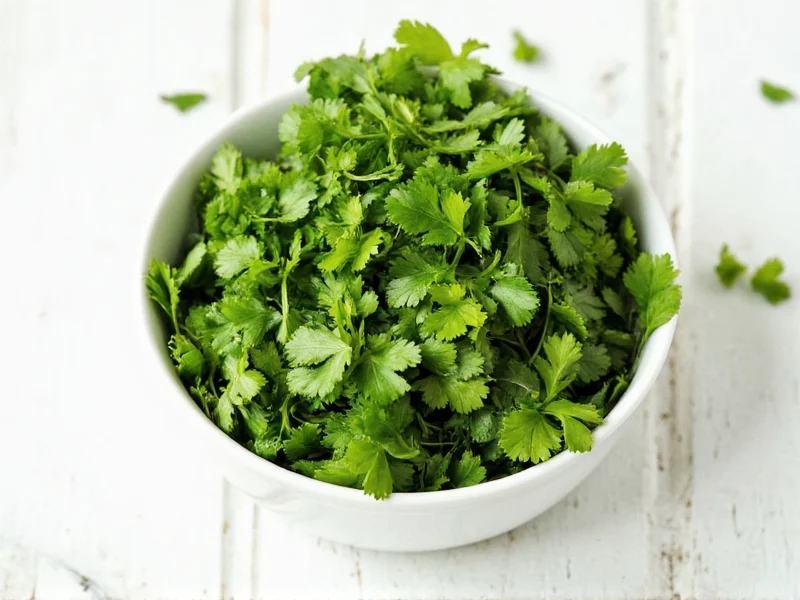The standard conversion ratio is 1 tablespoon of fresh cilantro equals 1 teaspoon of dried cilantro. This 3:1 ratio (fresh to dried) accounts for the concentration difference as drying removes moisture and intensifies flavor compounds. When substituting in recipes, use one-third the amount of dried cilantro compared to fresh for balanced results.
Understanding Cilantro Conversion Ratios
Getting the dried cilantro to fresh conversion right matters for flavor balance in your dishes. Fresh cilantro contains about 92% water, which evaporates during the drying process, concentrating the essential oils and flavor compounds. This concentration explains why you need less dried cilantro than fresh to achieve similar flavor intensity.
Practical Cilantro Conversion Chart
| Fresh Cilantro | Dried Cilantro | Best For |
|---|---|---|
| 1 teaspoon | ⅓ teaspoon | Small recipe adjustments|
| 1 tablespoon | 1 teaspoon | Standard substitution ratio|
| ¼ cup | 1¼ tablespoons | Medium-sized recipes|
| ½ cup | 2½ tablespoons | Larger dishes or batches|
| 1 cup | ⅓ cup | Significant recipe scaling
Flavor Differences Between Fresh and Dried Cilantro
While the 3:1 conversion ratio provides proper measurement equivalence, the flavor profiles differ significantly. Fresh cilantro offers bright, citrusy notes with a slight peppery finish, while dried cilantro develops earthier, more muted flavors with subtle cumin-like undertones. The drying process diminishes the volatile compounds responsible for fresh cilantro's distinctive aroma.
Chef Maria Rodriguez, a culinary instructor with 15 years of experience, explains: "Dried cilantro works better in slow-cooked dishes where its flavors have time to rehydrate and integrate, while fresh cilantro shines in finishing applications where its vibrant notes remain intact."
Expert Substitution Guidelines
Follow these professional tips when converting between fresh and dried cilantro:
- For soups and stews: Add dried cilantro early in cooking to allow rehydration; use the full 3:1 ratio
- For salsas and salads: Fresh cilantro is preferable, but if substituting dried, use half the standard ratio (1:6) for better flavor balance
- For spice blends: Dried cilantro integrates better with other dried spices; maintain the 3:1 ratio
- For finishing dishes: Fresh cilantro provides superior flavor impact; dried cilantro won't deliver the same bright finish
Storage Recommendations for Optimal Flavor
Proper storage affects how your cilantro performs in conversions:
- Fresh cilantro: Store stems in water like flowers, covered with a plastic bag in the refrigerator (lasts 7-10 days)
- Dried cilantro: Keep in an airtight container away from light and heat (maintains potency for 1-2 years)
- Freezing fresh cilantro: Chop and freeze in ice cube trays with water or oil for longer storage (use 1:1 with fresh in cooked dishes)
Remember that older dried herbs lose potency. If your dried cilantro has been stored longer than 18 months, increase the amount by 25% when substituting for fresh cilantro to compensate for flavor degradation.
When Substitution Isn't Ideal
Certain dishes simply don't translate well with dried cilantro substitutions. Traditional Mexican salsas, Vietnamese pho garnishes, and fresh herb salads rely on the distinctive bright notes of fresh cilantro that dried simply cannot replicate. In these cases, consider alternative fresh herbs like parsley or culantro if cilantro isn't available.
Measuring Techniques for Accuracy
Pack dried cilantro loosely in measuring spoons for accurate conversion. Unlike some dried herbs that benefit from packing, cilantro's delicate structure compresses easily, leading to over-concentration if packed too tightly. For critical recipes, consider weighing your herbs: 1 tablespoon fresh cilantro weighs approximately 2 grams, while 1 teaspoon dried weighs about 0.7 grams.
What is the exact dried cilantro to fresh conversion ratio?
The precise conversion is 1 tablespoon of fresh cilantro equals 1 teaspoon of dried cilantro, establishing a 3:1 ratio. This accounts for the moisture loss during drying that concentrates the flavor compounds in dried cilantro.
Can I substitute dried cilantro for fresh in guacamole?
While possible, dried cilantro doesn't work well in guacamole. The fresh herb's bright, citrusy notes are essential to authentic guacamole flavor. If you must substitute, use one-quarter the standard ratio (1:12) and add a squeeze of lime to compensate for lost freshness.
Why does the dried cilantro to fresh ratio matter in cooking?
The ratio matters because dried cilantro has three times the concentrated flavor of fresh due to moisture removal during drying. Using equal amounts would result in overpowering, potentially bitter flavors, while using too little would leave your dish lacking the intended herb profile.
How do I adjust recipes when converting from fresh to dried cilantro?
When converting recipes, reduce the amount by two-thirds—use one teaspoon of dried cilantro for every tablespoon of fresh called for. For long-cooking dishes, add dried cilantro early; for finishing touches, consider whether fresh would work better as dried won't provide the same bright finish.
Does the quality of dried cilantro affect the conversion ratio?
Yes, older dried cilantro loses potency. If your dried cilantro is more than 18 months old, increase the amount by 25% beyond the standard ratio. High-quality, recently dried cilantro maintains the proper 3:1 conversion ratio with fresh cilantro.











 浙公网安备
33010002000092号
浙公网安备
33010002000092号 浙B2-20120091-4
浙B2-20120091-4